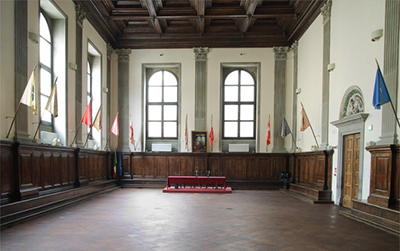The Palazzo di Parte Guelfa is the centerpiece of Piazza Guelfa and is a must see for any visitor to Florence as it is unlike any other of the palaces in Florence or throughout Italy.
This palace was the headquarters of the Guelfa political party during the years that they were in constant conflict with the Ghibellines. The Guelphs and the Ghibellines were supporters of the pope and the Holy Roman Empire, respectively.
Meeting Hall of the Palazzo di Parte Guelfa - in order to understand the origins of the entire structure, one has to understand that the origins of the Meeting Hall of the Palazzo di Parte Guelpha which was originally constructed at the beginning of the 14th century. This meeting hall was built by the Guelphs as an extention to the Santa Maria church. As of the 14th century, the Guelphs were the predominant political party in Florence, but they did not have their own official headquarters or official meeting place.
The design and construction of the first part of what would eventually become the palace as well as this crucial first meeting hall was entrusted to Filippo Brunelleschi. Brunelleschi has over time gone on to be recognized as one of the prioncipal Quattrocento architects, with the term Quottrocento referring to the artisitic and architectural styles of the late middle ages and then through the early and high renaissance. Brunelleschi was commisioned with the construction of the early palace facade and the meeting hall in 1420, which would place him and his work at the beginning of the Quattrocento period and very much in line with the international gothic tendencies that were prevalent at the time. The3 Meeting Hall of the Palazzo de Parte Guelfa is often refered to as the Brunelleschi Hall.
When you visit the palace you will clearly see not one monolitihic structure, but rather a collection of buildings that are joined together by way of a set of exterior staircases and walkways. One can observe, for instance, that the facade of the plaza is the section that most clearly demonstrates a beo-medieval style resulting from a renovation completed in 1921. Here you will see numerous and varied coats of arms, shields, and other emblematic expressions of devotion to the Pop, Florence, and the Guelph political party. Nonetheless, the most noteworthy aspects of the Guelph Party Palace are the chimney room, the courthouse, and the original meeting room desgined by Brunelleschi.
Throughout these halls and the entire interior of the Palazzo de Parte Guelfa you will also find a plethora of decorative elemts, many of which were actually rescued and repurposed items from the old market that once stood at the current site of the palace many centuries ago. Again, the entire building (or set of adjacent buildings if your will) was restored in a neo-medieval style in 1921 at the same time that the entire plaza was repurposed as the Plaza of the Republic. After the second world war, the palace once again had to be reconstructed in large part due to extensive damage from artillery.
These days, the Palazzo di Parte Guelfa serves as the headquarters for the historic Florence Football Organization or Calcio Storico Fiorentino (Italy is one of the only countries in the world where the word "football", or any slight variation thereof, is not used as Mussolini had banned the use of all anglocisms). The Meeting Hall of the Palazzo de Parte Guelfa is also still rented out and regularly used to host conventions, meetings, concerts, and other social gatherings. As such, this centuries old architectural marvel -in addition to being a very popular tourist destination and important piece of cultural patrimony- is also still very much an important venue and vital part of daily life in Florence.
Although the Palaces at Pitti, the Medici-Ricardi, and the Palazzo Vecchio are also all important buildings and meeting points, they are quite arguably not as unique in either their visual appeal or cultural history in the same way that the Palazzo di Parte Guelfa is. What's more, within the Guelph Palace, no element is quite as striking as the original meeting hall of the Palazzo di Parte Guelfa by Filippo Brunellesch is. Once inside, one cannot help but feel that they are standing in the epicenter of Florentine history, in the very spot where hundreds of crucial decisions were made and plans for action were hatched among the city's most powerfukl and influential men.




